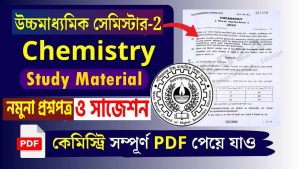Class 12 Chemistry Chapter Wise Notes: In this article we have provided CBSE Class 12 Chemistry Notes prepared by our experts to help students to prepare better for their examinations.
Class 12 Chemistry Chapter Wise Notes PDF: Class 12 Chemistry notes provide a detailed overview of important topics covered in the class 12 curriculum. These notes include detailed explanations on chapters such as
- Physical Chemistry: Solid State, Solutions, Electrochemistry, Chemical Kinetics, Surface Chemistry.
- Inorganic Chemistry: Concepts related to the p-Block elements, d- and f- Block Elements and Coordination Chemistry.
- Organic Chemistry: Concepts related to the Haloalkanes & Haloarenes, Alcohols, Phenols & Ether, C Chemistry, N-Chemistry, Biomolecules, Polymers and Chemistry in Everyday Life
These notes are designed to help in effective exam preparation and quick revision making them a valuable resource for mastering Class 12 Chemistry concepts.
Table of Contents
ToggleCBSE Class 12 Chemistry Notes Chapter Wise PDF
Below are the chapter-wise notes for CBSE Class 12 Chemistry:
| CBSE Chemistry Notes For Class 12 – Chapter-wise | |
|---|---|
| Chapter 1 The Solid State | |
| Chapter 2 Solutions | |
| Chapter 3 Electrochemistry | |
| Chapter 4 Chemical Kinetics | |
| Chapter 5 Surface Chemistry | |
| Chapter 6 General Principles and Processes of Isolation of Elements | |
| Chapter 7 The p-Block Elements | |
| Chapter 8 The d-and f-Block Elements | |
| Chapter 9 Coordination Compounds | |
| Chapter 10 Haloalkanes and Haloarenes | |
| Chapter 11 Alcohols, Phenols, and Ethers | |
| Chapter 12 Aldehydes, Ketones, and Carboxylic Acids | |
| Chapter 13 Amines | |
| Chapter 14 Biomolecules |
CBSE Class 12 Chemistry Notes Topic Wise Summary
Here is a topic-wise summary of the CBSE Class 12 Chemistry notes:
Chapter 1 The Solid State
This chapter explain the nature of solids, focusing on their structures and properties. Key topics include unit cells, types of lattices, and crystal systems. It covers the classification of solids into ionic, covalent, molecular, and metallic types. The chapter also discusses imperfections in solids and their effects on material properties.
Chapter 2 Solutions
The chapter covers the nature of solutions, including the types (saturated, unsaturated, supersaturated) and concentration units such as molarity and molality. It discusses colligative properties, including boiling point elevation, freezing point depression, and osmotic pressure, explaining how solute concentration affects these properties.
Chapter 3 Electrochemistry
This chapter focuses on electrochemical cells and their functioning. It covers redox reactions, galvanic cells, electrolytic cells, and standard electrode potentials. Key concepts include Faraday’s laws of electrolysis, and the application of electrochemistry in real-life scenarios like batteries and electroplating.
Chapter 4 Chemical Kinetics
Chemical Kinetics deals with the study of reaction rates and factors influencing them. Topics include the rate of reaction, order of reaction, rate laws, and the Arrhenius equation. The chapter explores how factors like temperature, concentration, and catalysts affect reaction rates.
Chapter 5 Surface Chemistry
Surface Chemistry examines phenomena at surfaces and interfaces, such as adsorption, catalysis, and colloidal systems. It includes the study of adsorption isotherms (Freundlich and Langmuir), and the properties and types of colloids, including sols, gels, and emulsions.
Chapter 6 General Principles and Processes of Isolation of Elements
This chapter outlines the general methods for extracting metals from their ores. It covers principles of metallurgy, including ore concentration, extraction methods (pyrometallurgy, hydrometallurgy), and refining processes.
Chapter 7 The p-Block Elements
The p-Block Elements chapter covers the chemistry of elements in groups 13 to 18 of the periodic table. It includes the properties, reactions, and uses of these elements and their compounds, such as boron, carbon, nitrogen, oxygen, and halogens.
Chapter 8 The d-and f-Block Elements
This chapter explain the properties and reactions of transition metals (d-block) and inner transition metals (f-block). It includes discussions on electronic configurations, oxidation states, color, and magnetic properties, as well as the formation and significance of complex compounds.
Chapter 9 Coordination Compounds
Coordination Compounds discusses the structure and bonding of coordination complexes. It covers coordination number, types of ligands, nomenclature, VSEPR theory, and isomerism in coordination compounds.
Chapter 10 Haloalkanes and Haloarenes
This chapter investigates the properties and reactions of haloalkanes (alkyl halides) and haloarenes (aryl halides). It discusses their methods of preparation, mechanisms of substitution and elimination reactions, and their applications in organic synthesis.
Chapter 11 Alcohols, Phenols, and Ethers
This chapter covers the properties and reactions of alcohols, phenols, and ethers. It includes discussions on their preparation, chemical behavior, and uses in various chemical processes and industries.
Chapter 12 Aldehydes, Ketones, and Carboxylic Acids
This chapter focuses on the chemistry of aldehydes, ketones, and carboxylic acids. It includes their preparation, reactions, and important tests for their identification. The chapter also explores their roles in organic synthesis and their applications.
Chapter 13 Amines
Amines are discussed in this chapter, including their classification, preparation, and reactions. It covers the properties of primary, secondary, and tertiary amines, and their use in various chemical processes.
Chapter 14 Biomolecules
This chapter covers the chemistry of biomolecules, including carbohydrates, proteins, lipids, and nucleic acids. It explores their structures, functions, and roles in biological systems.
Chapter 15 Polymers
The Polymers chapter explain the types, properties, and methods of polymerization. It includes discussions on addition and condensation polymers, as well as their applications in various industries.
Chapter 16 Chemistry in Everyday Life
This chapter examines the role of chemistry in daily life. It covers the chemistry behind everyday products and processes, including pharmaceuticals, detergents, and food additives, and their impact on health and the environment.
Keyword: CBSE Class 12 Chemistry Notes, Chemistry Notes Chapter Wise PDF, Chemistry Notes Topic Wise Summary, CBSE Notes for Class 12 Chemistry, CBSE Class 12 Chemistry Notes for All Chapters
Benefits of CBSE Class 12 Chemistry Notes
CBSE Class 12 Chemistry notes offer several benefits for students preparing for their board exams and competitive exams like JEE, NEET, and others. Here are some key advantages:
1. Concise and Well-Structured Content
- Notes summarize the vast syllabus in an easy-to-understand manner.
- Important formulas, reactions, and concepts are highlighted for quick revision.
2. Time-Saving for Exam Preparation
- Helps in quick revision before exams, reducing the need to go through the entire textbook.
- Saves time by providing a well-organized format of important topics.
3. Clarity of Concepts
- Simplifies complex topics such as Organic Chemistry mechanisms, Electrochemistry, and Surface Chemistry.
- Provides step-by-step explanations of numerical problems and derivations.
4. Useful for Competitive Exams
- Covers NCERT-based questions that are crucial for JEE, NEET, and other entrance exams.
- Includes important reaction mechanisms and formula sheets for quick recall.
5. Better Retention and Recall
- Mind maps, flowcharts, and summary tables help in better retention.
- Bullet points and short explanations make it easier to remember key details.
6. Chapter-Wise Breakdown for Systematic Study
- Organized chapter-wise, making it easier to focus on weak areas.
- Helps in following a structured study plan.
7. Enhances Answer Writing Skills
- Provides a clear idea of how to frame answers effectively in board exams.
- Includes sample answers, previous year questions, and important points to score better.
8. Boosts Confidence
- By providing quick revision material, students feel more confident before exams.
- Eliminates last-minute stress by offering a handy resource for revision.
Would you like a specific chapter’s notes or guidance on how to make effective chemistry notes?
CBSE Class 12 Chemistry Notes FAQs
How do Class 12 Chemistry notes help in understanding complex concepts?
Class 12 Chemistry notes aid in understanding complex concepts by breaking down difficult topics, providing structured content, and using visual aids. They highlight key points, offer examples, and summarize chapters, making it easier to grasp, retain, and apply the information in practical scenarios.
How do Class 12 Chemistry notes enhance exam preparation?
Class 12 Chemistry notes enhance exam preparation by providing structured and concise content. They highlight key concepts and formulas, aiding in quick revision and better retention. These notes are valuable for CBSE exams and competitive exams like NEET and JEE Main, improving problem-solving skills and overall performance.
Can these notes be used for quick revision before exams?
Yes, Class 12 Chemistry notes are ideal for quick revision before exams. They highlight key concepts, formulas, and summaries, making it easier to review important information efficiently. With structured content and concise explanations, they help reinforce your understanding in a short amount of time
Are these notes useful for competitive exams like IIT JEE and NEET?
Yes, Class 12 Chemistry notes are highly useful for competitive exams like IIT JEE and NEET. They cover key concepts, important formulas, and provide concise explanations. These notes help in quick revision, reinforcing understanding, and enhancing problem-solving skills essential for acing competitive exams.
Will solving chemistry sample papers help a student during the Board exam?
Absolutely! Solving chemistry sample papers can significantly help a student during the Board exam in several ways:
- Familiarity with Exam Pattern: Sample papers provide insight into the exam pattern, question types, and marking schemes.
- Time Management: Practicing with sample papers helps students manage their time effectively during the actual exam.
- Identifying Weak Areas: Students can identify their weak areas and focus on improving them.
- Boosting Confidence: Regular practice can boost confidence and reduce exam anxiety.
- Enhancing Problem-Solving Skills: It helps in honing problem-solving skills and applying concepts learned.
For students appearing for CBSE, ISC, WBCHSE, NEET, and JEE Main, solving sample papers is an excellent way to enhance their preparation and improve their overall performance.








